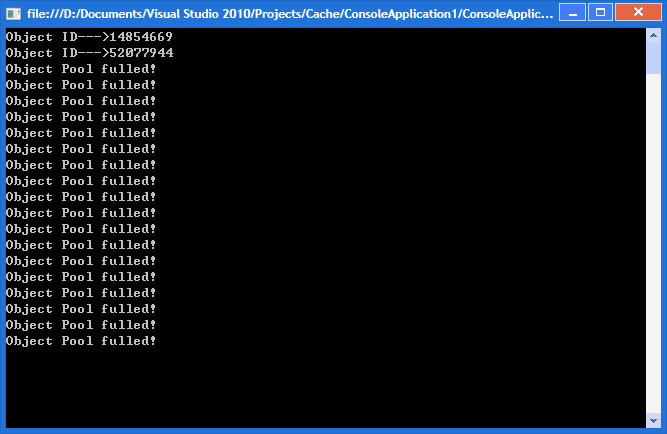对象池服务可以减少从头创建每个对象的系统开销。在激活对象时,它从池中提取。在停用对象时,它放回池中,等待下一个请求。
我们来看下主线程中,如何与对象池打交道:
static void Main(string[] args) { InstancePoolResolver.Register<OrderQueryServiceInterface, OrderQueryService>(); while (true) { Thread.Sleep(2000); Console.Clear(); for (int i = 0; i < 20;i++ ) { ThreadPool.QueueUserWorkItem(new WaitCallback(ConsumeObject)); } } } private static void ConsumeObject(object state) { OrderQueryServiceInterface srv = null; try { using (srv = InstancePoolResolver.Resolve<OrderQueryServiceInterface>()) //从对象池中取得对象,没有可用对象则throw exception { Console.WriteLine("Object ID--->" + srv.GetHashCode()); Thread.Sleep(1000); //故意长时间占用对象 } } catch (Exception ex) { Console.WriteLine(ex.Message); } finally { if (srv != null) srv.Dispose(); } }
运行效果:


是通过Attribute打tag上去的
下面来看看最核心的InstancePoolResolver类
public sealed class InstancePoolResolver { private static Dictionary<Type, Type> typeMappers = new Dictionary<Type, Type>(); private static Dictionary<Type, int> typeMappersMaxInstanceCount = new Dictionary<Type, int>(); private static Dictionary<Type, List<PoolableObject>> typeInstances = new Dictionary<Type, List<PoolableObject>>(); private static object o4lock = new object(); public static void Register<T, TProvider>() where TProvider : class, new() { if (typeMappers.ContainsKey(typeof(T))) throw new Exception("Key existed"); lock (o4lock) { Type t = typeof(T); typeMappers.Add(t, typeof(TProvider)); typeInstances.Add(t, new List<PoolableObject>()); InstanceSettingAttribute setting = GetInstanceSettingAttribute(typeof(TProvider)); typeMappersMaxInstanceCount.Add(t, setting.MaxInstanceGlobal); } } public static T Resolve<T>() where T: PoolableObject { Type t = typeof(T); if (!typeMappers.ContainsKey(t) || !typeInstances.ContainsKey(t)) throw new Exception("Key empty, register please"); lock (o4lock) { List<PoolableObject> instances = typeInstances[t]; if (instances == null) { instances = new List<PoolableObject>(); typeInstances[t] = instances; } foreach (PoolableObject o in instances)//是否已经存在已有闲置对象 { if (o.IsInPool) { o.IsInPool = false; return (T)o; } } if (instances.Count < typeMappersMaxInstanceCount[t])//new新对象到对象池中 { Type type = typeMappers[t]; PoolableObject obj = (PoolableObject)Activator.CreateInstance(type); instances.Add(obj); obj.IsInPool = false; return (T)obj; } } throw new Exception("Object Pool fulled!"); //没有多余的资源 } private static InstanceSettingAttribute GetInstanceSettingAttribute(Type type) { object[] attrs = type.GetCustomAttributes(typeof(InstanceSettingAttribute), false); if (attrs == null || attrs.Count() == 0) return new InstanceSettingAttribute() { MaxInstanceGlobal=10}; return (InstanceSettingAttribute)attrs[0]; } }
其实很简单,只是多了个获取Attribute的函数